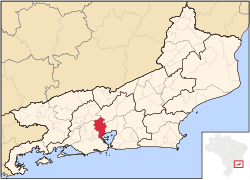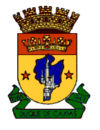Duque de Caxias, Rio de Janeiro
| Duque de Caxias | |||
|---|---|---|---|
| Municipality | |||
| The Municipality of Duque de Caxias | |||

Municipal Library in the city center, designed by Oscar Niemeyer
|
|||
|
|||
 Location of Duque de Caxias in the State of Rio de Janeiro |
|||
| Location in Brazil | |||
| Coordinates: 22°47′09″S 43°18′43″W / 22.78583°S 43.31194°W | |||
| Country |
|
||
| Region | Southeast | ||
| State |
|
||
| Founded | December 31, 1943 | ||
| Government | |||
| • Mayor | Alexandre Cardoso (2013–2016) | ||
| Area | |||
| • Total | 464.573 km2 (179.373 sq mi) | ||
| Elevation | 7 m (23 ft) | ||
| Population (2008) | |||
| • Total | 873,921 | ||
| • Density | 1,860.61/km2 (4,818.23/sq mi) | ||
| Time zone | UTC-3 | ||
| Postal Code | 25000-000 | ||
| Area code(s) | +55 21 | ||
| Website | Duque de Caxias, Rio de Janeiro | ||
Coordinates: 22°47′09″S 43°18′43″W / 22.78583°S 43.31194°W
Duque de Caxias (Portuguese pronunciation: [ˈduki dʒi kaˈʃiɐʃ], Duke of Caxias) is a city on Guanabara Bay in Rio de Janeiro state, southeastern Brazil.
It is bordered by Rio de Janeiro city to the south. Its population was 873,921 (2013) and its area is 465 km², making it the second most populous suburb of Rio de Janeiro city The city is the third most populous in Rio de Janeiro Metropolitan Area. The current mayor is Alexandre Cardoso.
It is named after Luís Alves de Lima e Silva, Duke of Caxias, who was born there in 1803. The city is the seat of the Roman Catholic Diocese of Duque de Caxias. Its important industries are chemicals and oil refining.
Duque de Caxias Futebol Clube is the local football team of the city. The club plays their home matches at Estádio Romário de Souza Faria, which has a maximum capacity of 10,000 people. Estádio De Los Larios, located in the district of Xerém, has a maximum capacity of 11,000 people and it is the home ground of Esporte Clube Tigres do Brasil.
...
Wikipedia



